1lumen selects and reviews products personally. We may earn affiliate commissions through our links, which help support our testing.
Olight Odin GL Mini review
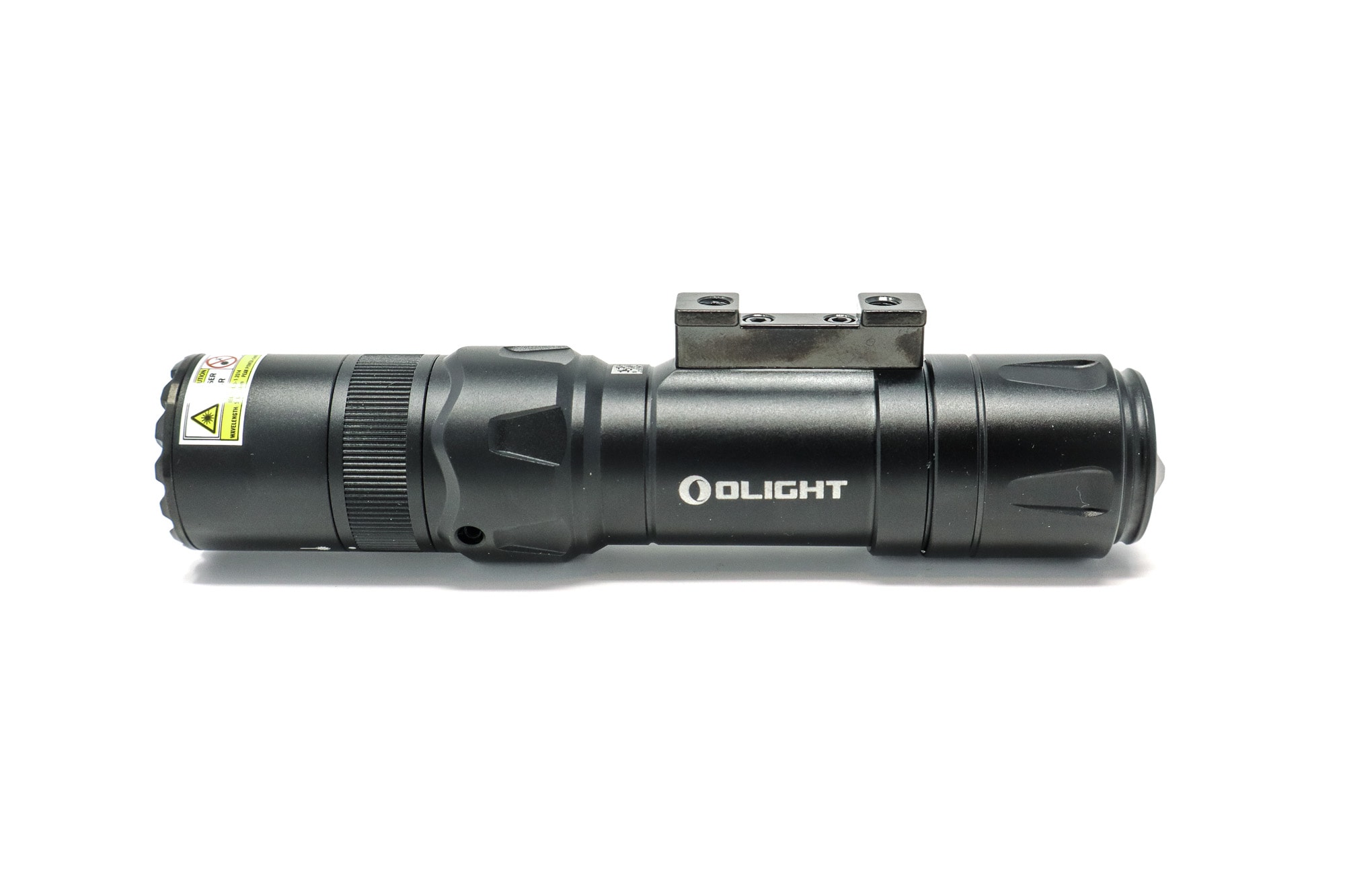
Olight Odin GL Mini specifications
| Brand & Model | Olight Odin GL Mini |
|---|---|
| Flashlight category | Weapon mount light, Tactical |
| LED | Unknown |
| Max. output | 1,000 lumens |
| Max. beam distance | 180 meters |
| Max. beam intensity | 8,100 cd |
| Battery config. | 1x 18500 |
| Onboard charging | Olight MCC |
| Main modes | 2 |
| Blinkies | N/A |
| Waterproof | IPX4 |
| Review publication date | April 2024 |
Review intro:
So… you’re on a flashlight review website. Do I need to introduce Olight to you? Likely not – whether you like Olight or not, if you’re here, you probably know a bit about them. Olight has a wide portfolio of flashlights from lumen monsters light the Marauder, to the long distance Javelot light, duty-focused Warriors, the prolific i3E’s, etc. They even make my favorite lanterns, the Olantern Classic 2 Pro and Olantern Classic Mini. If you’re in the market for a flashlight, there’s a high likelihood that Olight has a product to suit your needs.
What’s on the docket today is a little bit different… the Olight Odin GL Mini has one goal in mind: to be your go-to weapon-mounted light for long guns with a focus on home-defense. The Odin family has several similar offerings with tweaks to meet specific needs. The Odin GL Mini is, as you would guess, a slightly smaller Odin. And the GL indicates that this light features a green laser. I was in the market for a weapon-mount light for a recent firearm acquisition, so I was curious if this Olight would fill in the lighting needs for that. Does it? Let’s see!
To get started with the Olight Odin GL Mini, you’ll want to remove the lens protection film. After that, twist off the tailcap and remove the insulating film from the battery. Put that tailcap back in place and you’re off to the races.
What’s in the package
Olight has just a couple of design languages when it comes to packaging. Pricier lights tend to come in magnetic-closure boxes with all of the goodies neatly arranged in foam and compartmented boxes. The Odin GL Mini is one of those lights. After removing the Odin and the surrounding foam, you’ll see the remaining contents of the box, neatly arranged. The contents encompassed:
- Olight Odin GL Mini
- Olight 18500 battery
- Picatinny rail mount
- MCC charging cable
- Magnetic remote switch
- Hex wrenches
- Various screws
- Zip ties
- Manual
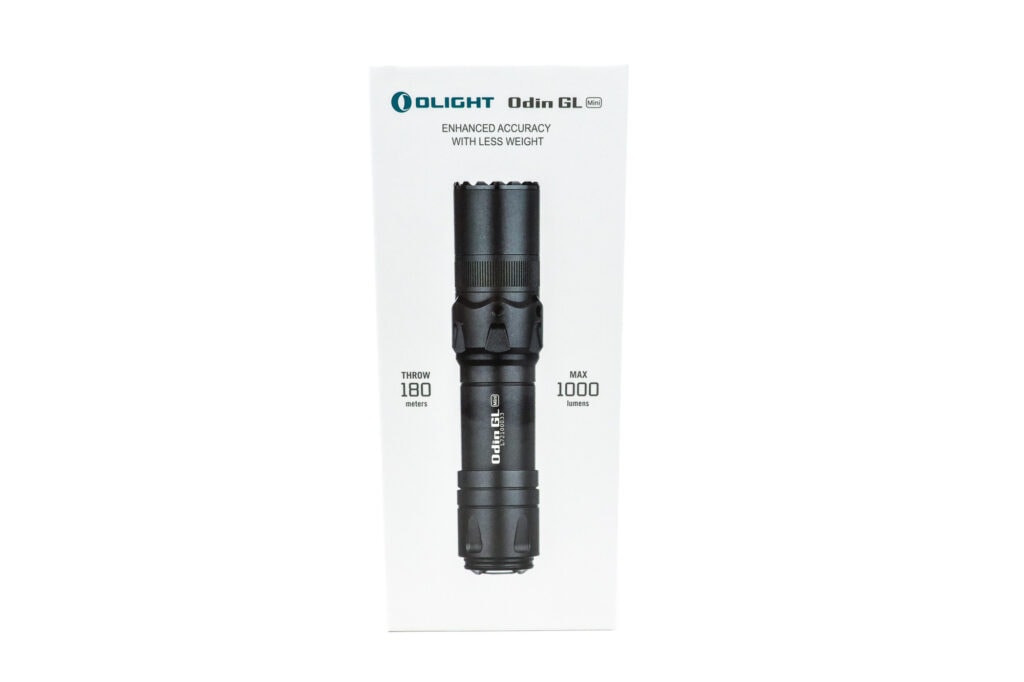
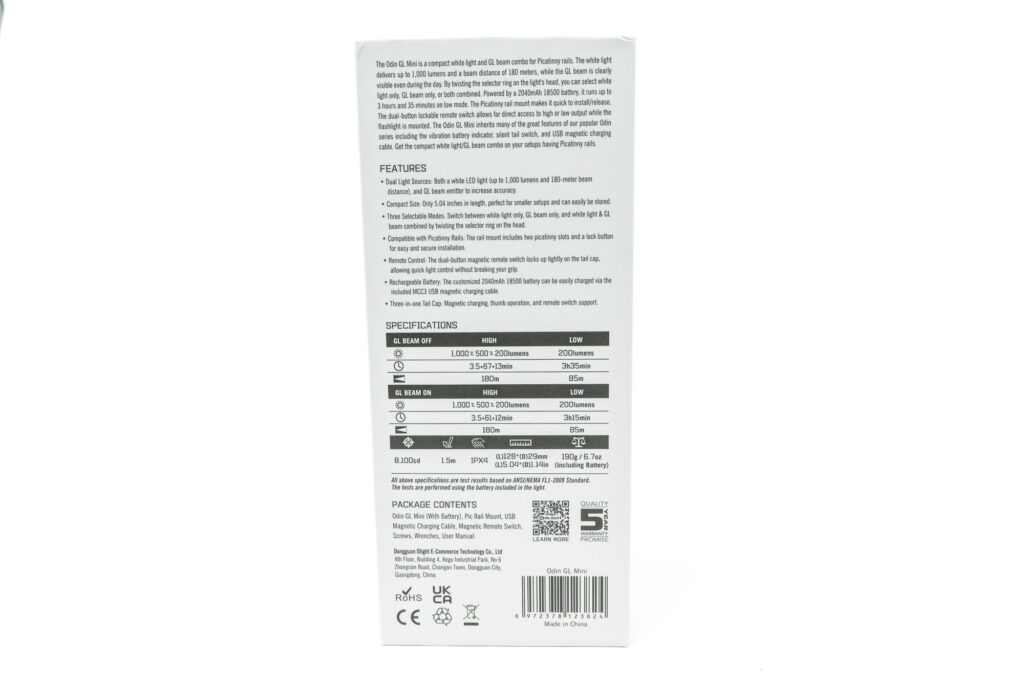

Flashlight in use, Build Quality, and Warranty
The Odin GL Mini is purpose-built to be a great weapon-mounted / tactical flashlight. In order to meet these goals, form and function need to come together just right, and I think Olight really delivered here. There is one main switch, a two-stage e-switch in the tail, that provides on/off/momentary functionality along with predictable access to High/Low modes. In order to switch between laser, white light, and laser + white light combo, a magnetic switch ring at the head of the flashlight provides easy access to those modes.
The body of the flashlight has a mounting point built-in. It looks like you could remove that with some hex screws if you really felt like it, but I’m not sure why you would. That mount point pairs perfectly with the Picatinny rail mount that is provided. You can slide the flashlight into one of two slots on the mount, depending on what orientation fits your firearm the best. For my test setup, I slide the Odin into the edge slot of the Pic mount. My firearm has MLOK attachment points, so in order to use the Odin, I needed to attach an MLOK-to-Picatinny rail section that I had on hand. That was all pretty straight forward, but when I tried putting it all together with the flashlight being around 11 o’clock on the firearm, the Odin did have some interference with the MBUS (Magpul Back-Up Sights) that I had mounted. If I mount this flashlight permanently, I would need to adjust the fitment to account for that.
The package for the Olight Odin GL Mini included a remote pressure switch, complete with a Picatinny carrier for it. Unfortunately, my test-fit firearm has a lightweight handguard that doesn’t have a full Pic rail on top, so I would either need to mount this in a different location or remove it from the Pic mount and zip-tie it right to the handguard. The remote pressure switch has a small pad up front for Low mode and a large pad for High mode. Those pads are silent and work really well. The remote switch attaches to the tail of the Odin with magnetic attraction plus a detent ring that locks it in place.
Once you’ve got all of that situated, you can dial-in the green laser zero using the smaller of the provided hex keys by turning two small screws on the head of the flashlight. This operates much like turrets on an optic. Note, the manual does state: “The Odin GL Mini can only be mounted on Picatinny rails with the included Picatinny mount. Please don’t mount it on any M-LOK rails, otherwise the GL beam cannot be zeroed properly.“ While I have confirmed that I was able to mount it ok on MLOK rails (via a Picatinny adapter), it seems that Olight discourages this. The “regular” Odin Mini seems to come in an MLOK model, which is nice – but you also sacrifice the laser functionality.
Build quality? I feel quite confident in the products that Olight produces. I have never been disappointed in their quality and have only ever had one problem. I contacted Olight about it and they promptly replaced it, no questions asked. And that was one of their least-expensive products, an Obulb that a child didn’t treat so nicely. I have had several Olight weapon lights that I’ve put hundreds of rounds through (each) and they’ve never skipped a beat.
Warranty information, from Olight’s website:
If you purchased an Olight® product from the USA after January 1st, 2023, the local service centers will honor your LIFETIME WARRANTY for your purchase. If your Olight product (including its structure, built-in battery, LED, or lens) ever experiences any issues, we promise to take care of it. If we are unable to repair your product, we will promptly replace it with a product in perfect working condition, which will be of equal or better physical condition. If your purchase is a limited or discontinued edition of Olight product, we will repair or replace it with another Olight product of the same or higher value.
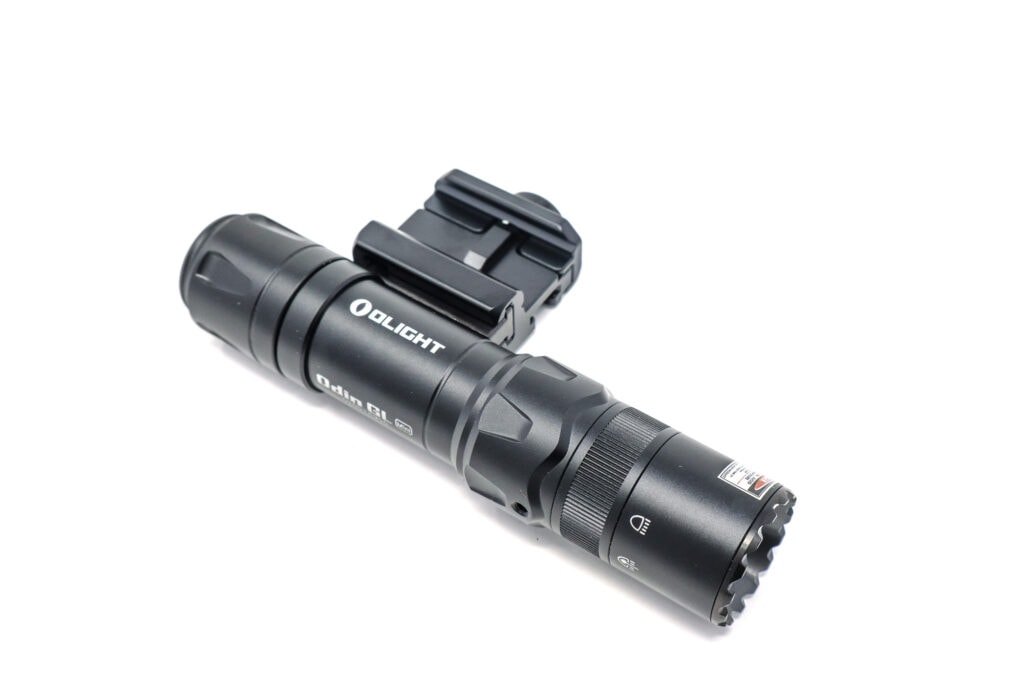
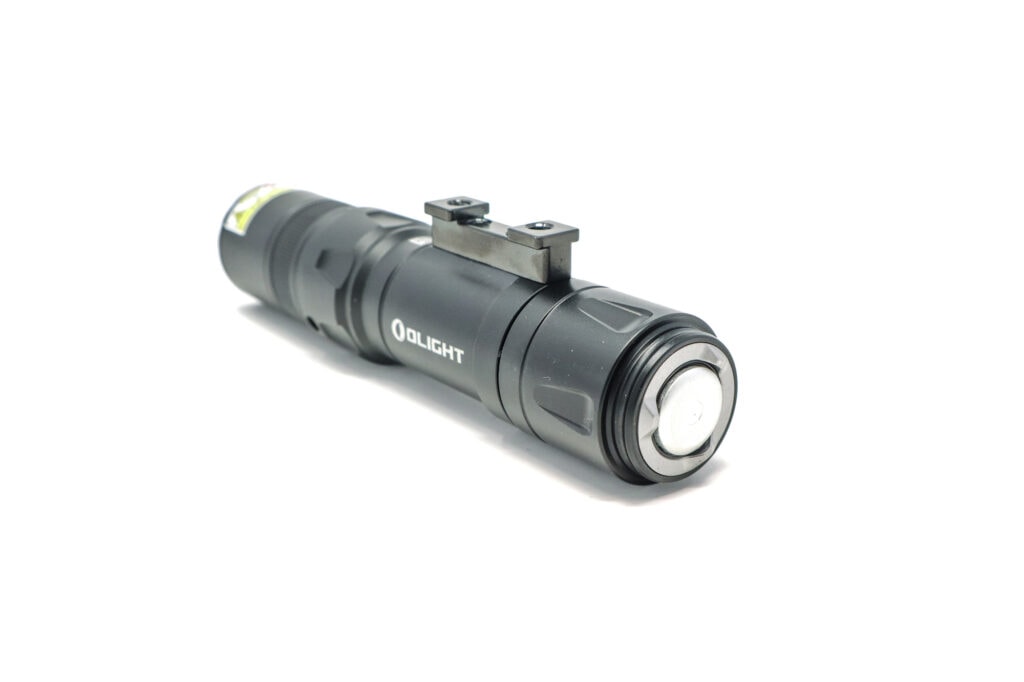
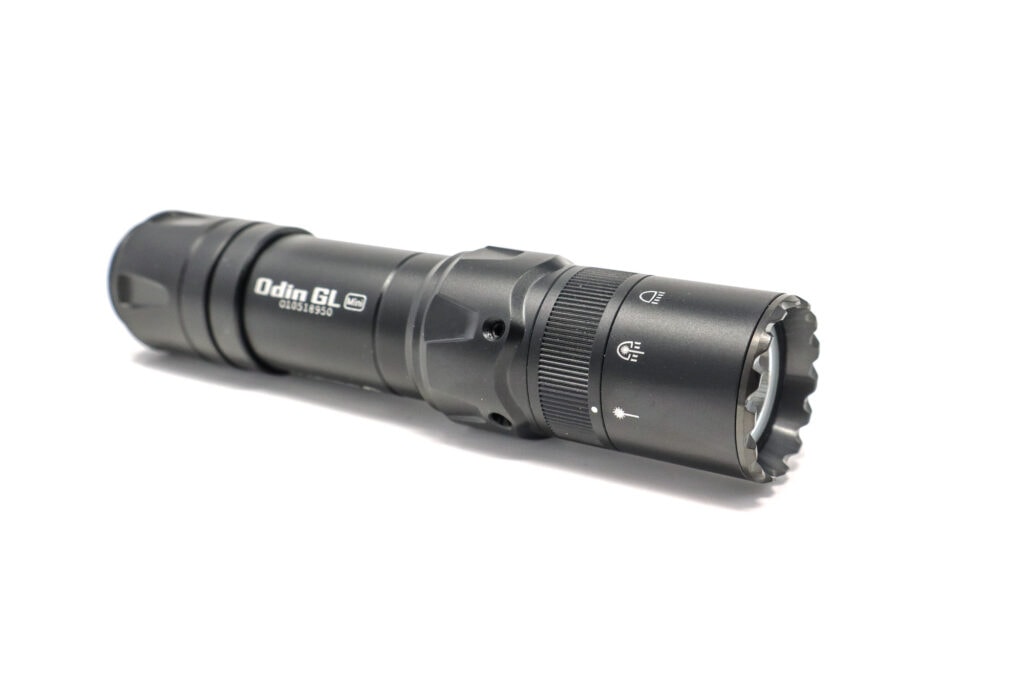
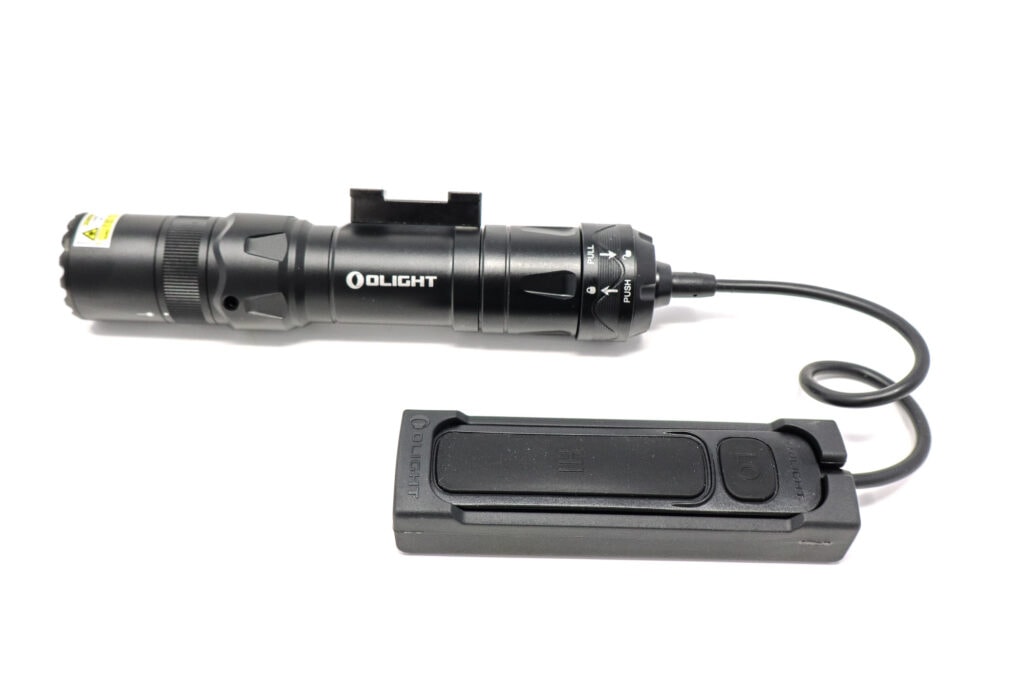
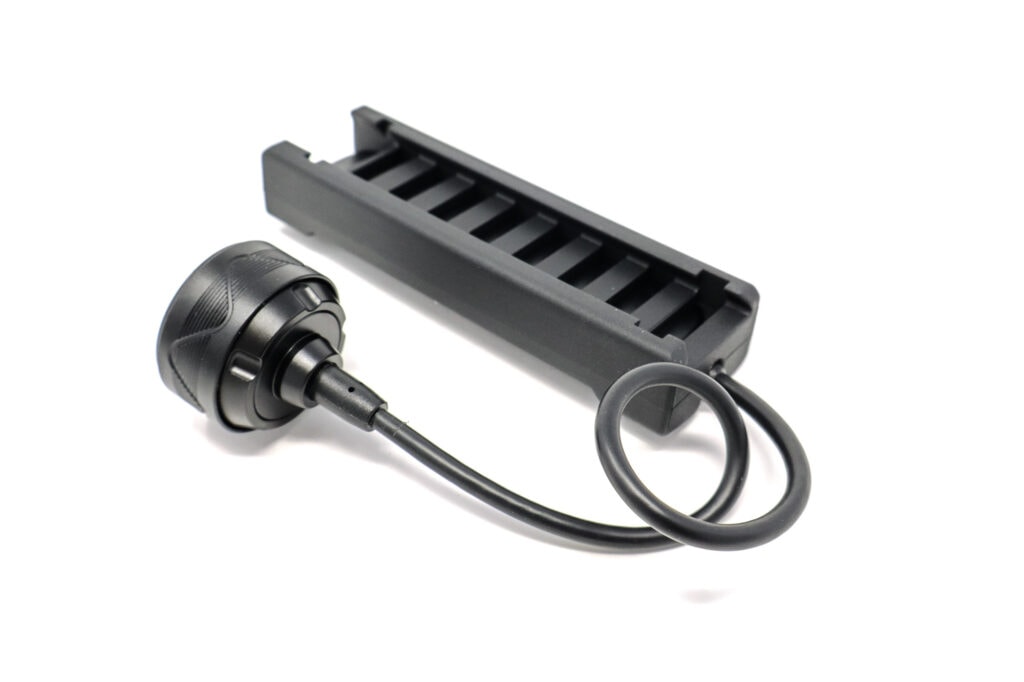
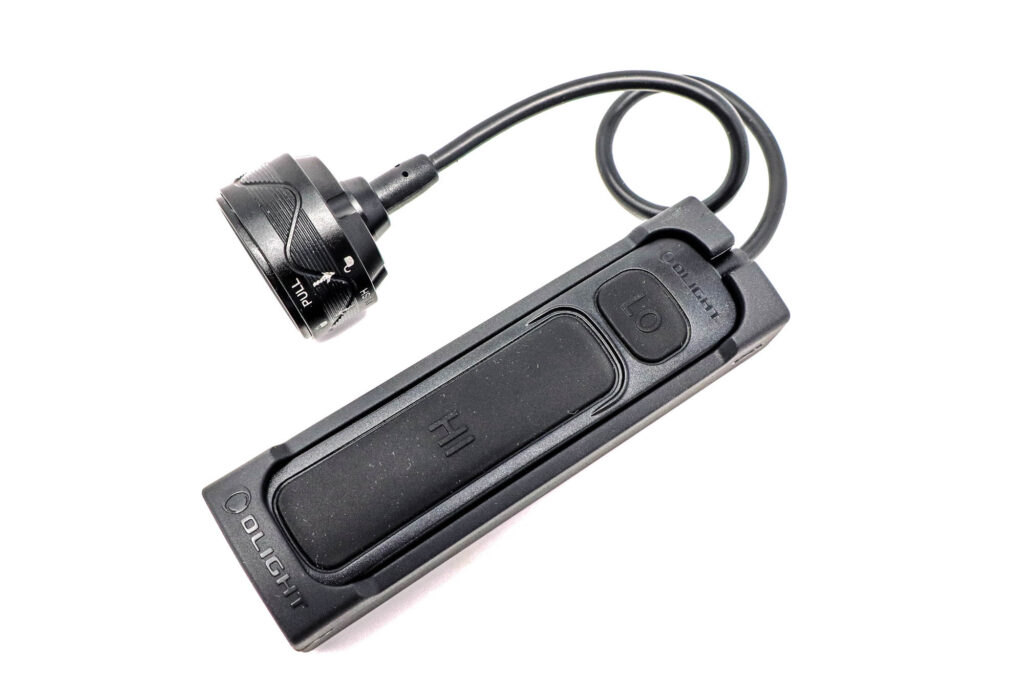
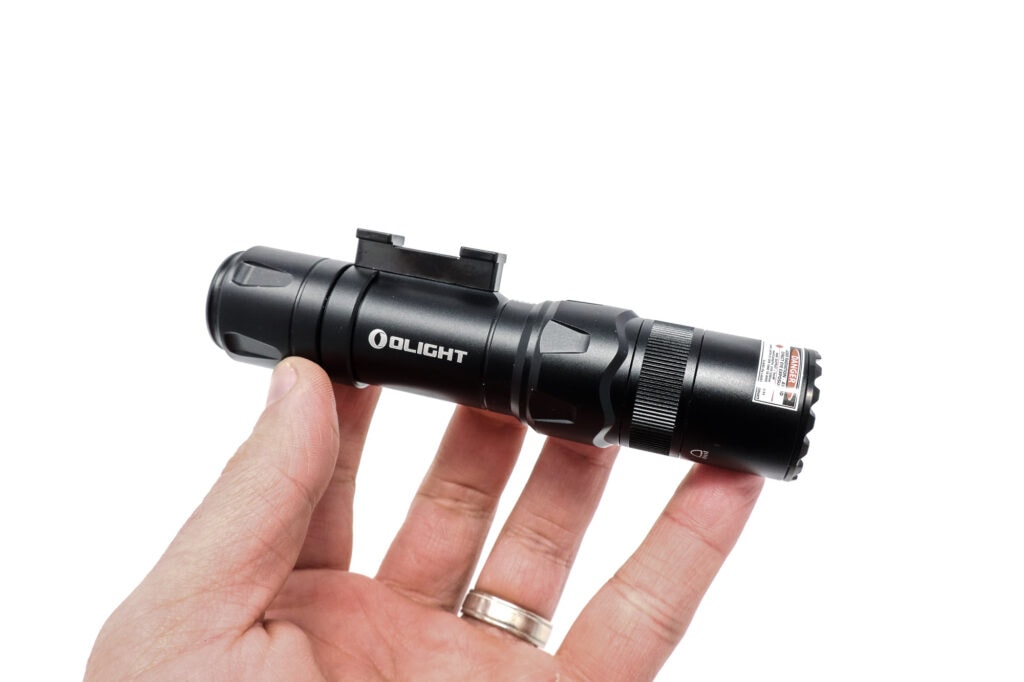
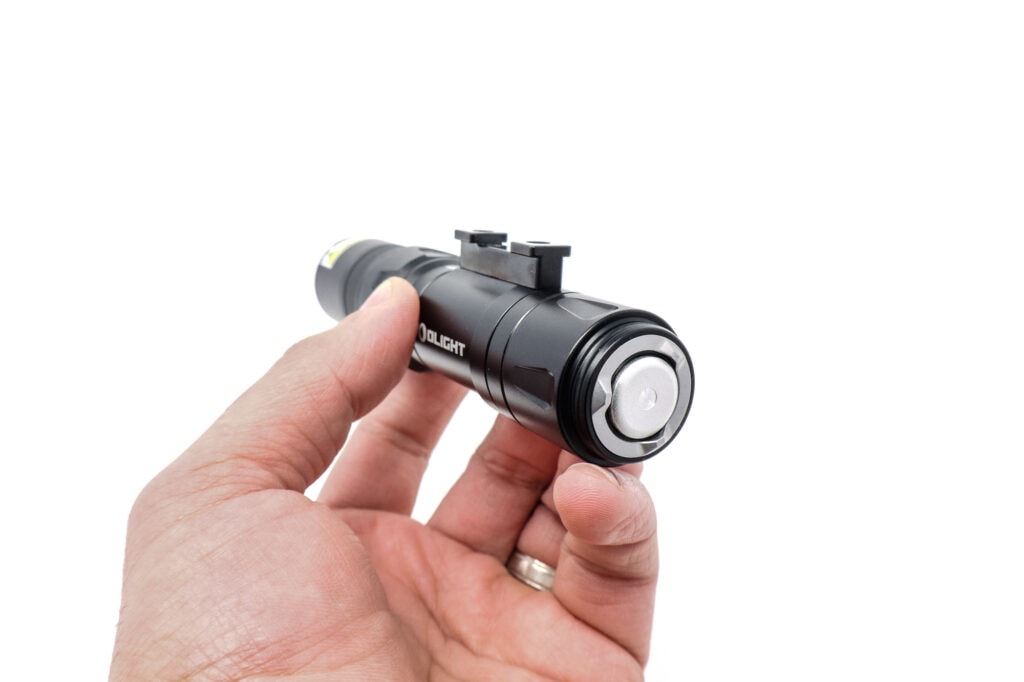
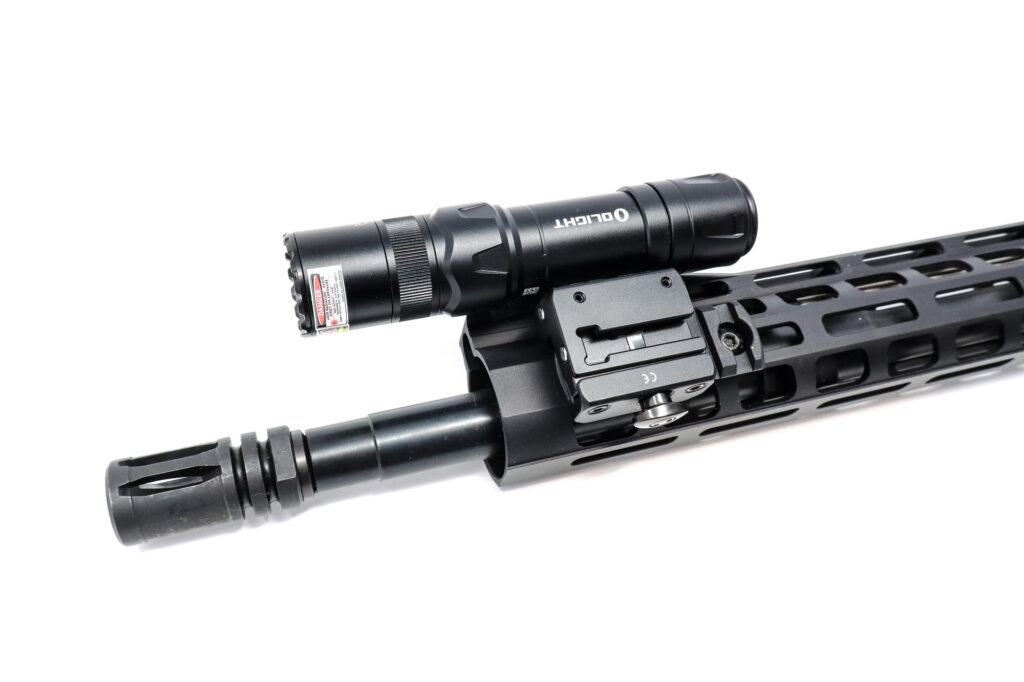
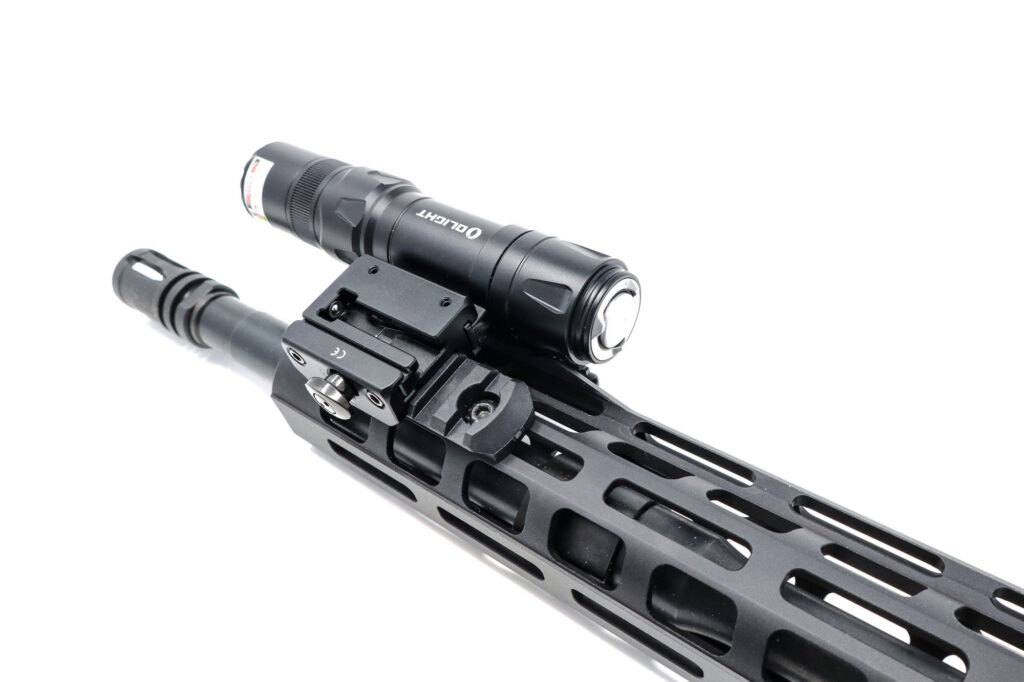
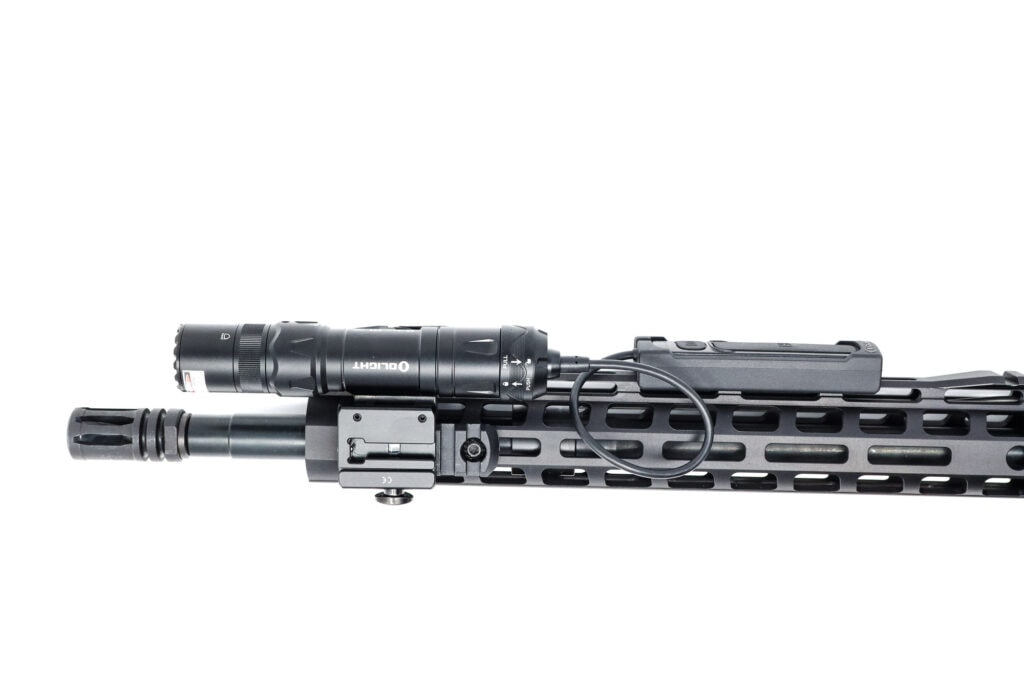
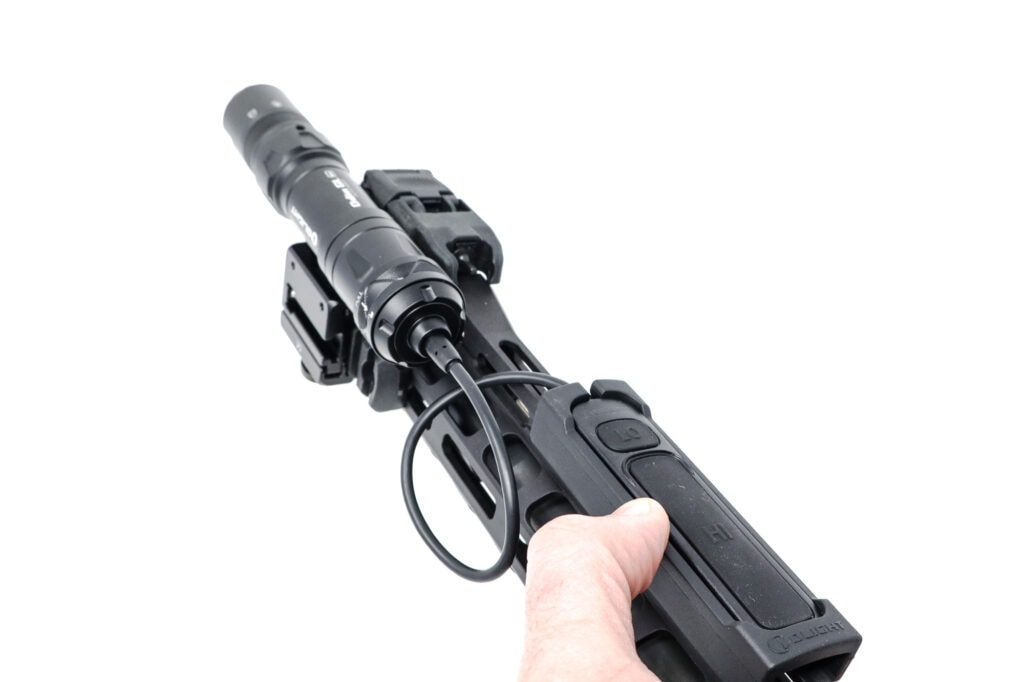
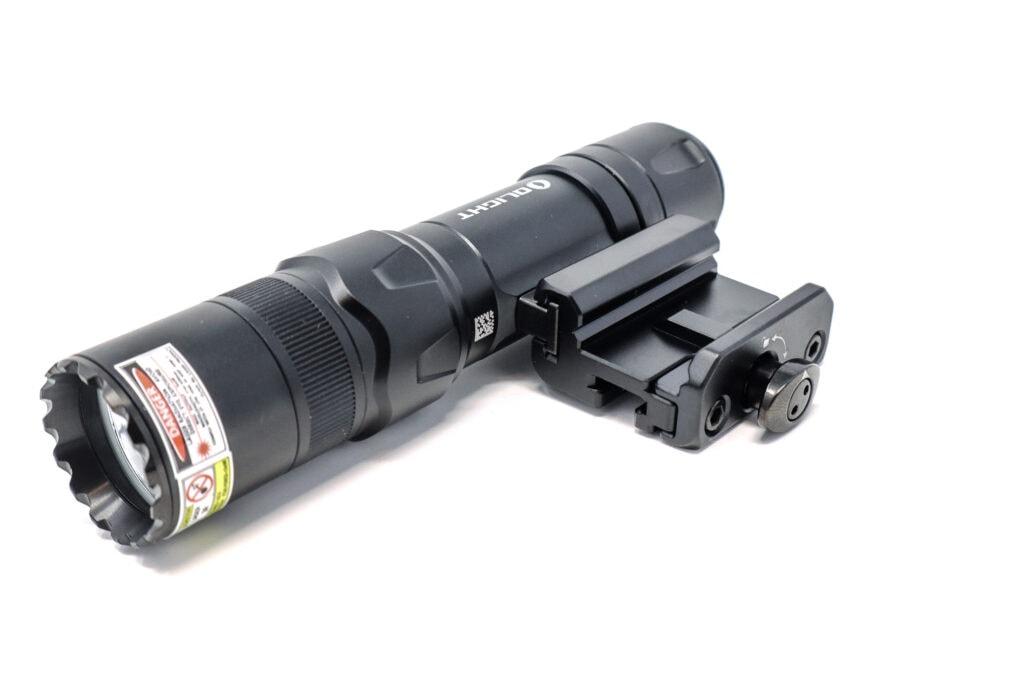
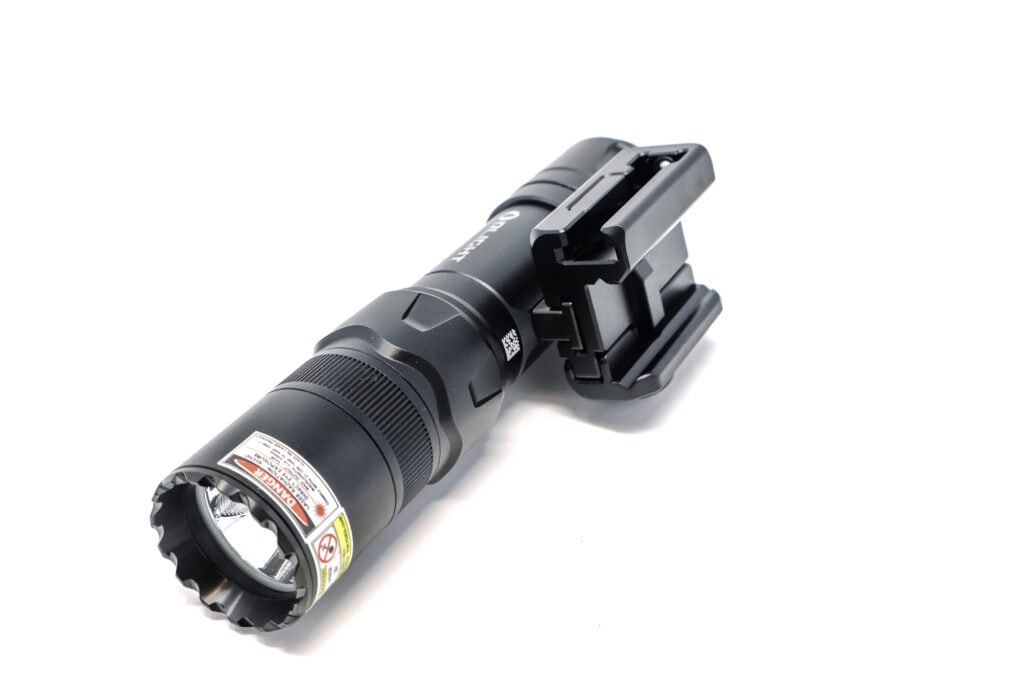
LED, Lens, Bezel, Beam, and Reflector
The Odin GL Mini uses a pretty nice looking bezel that has small crenulation in a sort of swirl pattern. This bezel holds a glass lens in place, which sits atop a smooth reflector. In the center of the reflector is a domeless quad-die LED of unspecified make and model, in typical Olight fashion. If I were to take an educated guess, it is probably a Cree XHP35.2 HI. The beam that this LED and reflector combo makes is almost like it’s from a TIR. There is a distinct, even hotspot with a clean cutoff, and then a wide even spill. It’s a bit odd coming from a reflector, but if you’ve ever used an Acebeam Pokelit AA, it’s the same kind of effect.
In addition to the white LED, there’s also the green laser… putting the “GL” in Odin GL Mini. This shines through a hole in the reflector. The laser is very bright and is designated as Class 3R with a max output of 5mW with a wavelength between 510 and 530nm. While the white LED is helpful for seeing what you’re aiming at, the laser is helpful for showing where you’re aiming and can be a helpful directional aid and perhaps even a strategic deterrent.
Spectral measurements:
I used the Opple Light Master to measure the flashlight at 5 meters distance.
| Mode: | CCT: | CRI Ra: | duv |
|---|---|---|---|
| Turbo | 5845 K | 82.5 | +0.0033 |
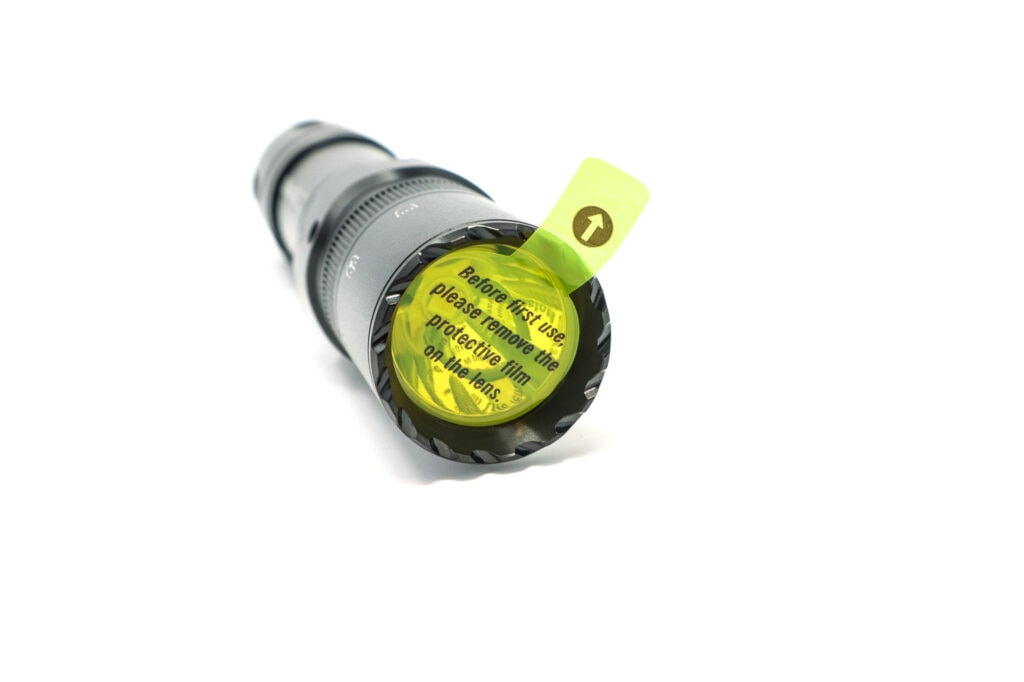
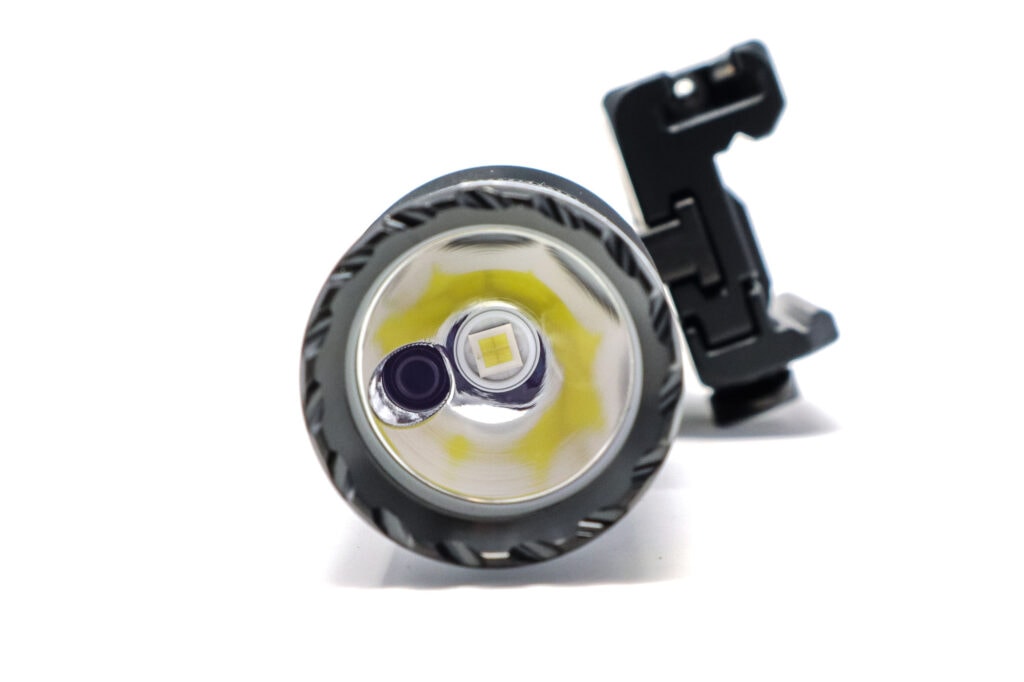
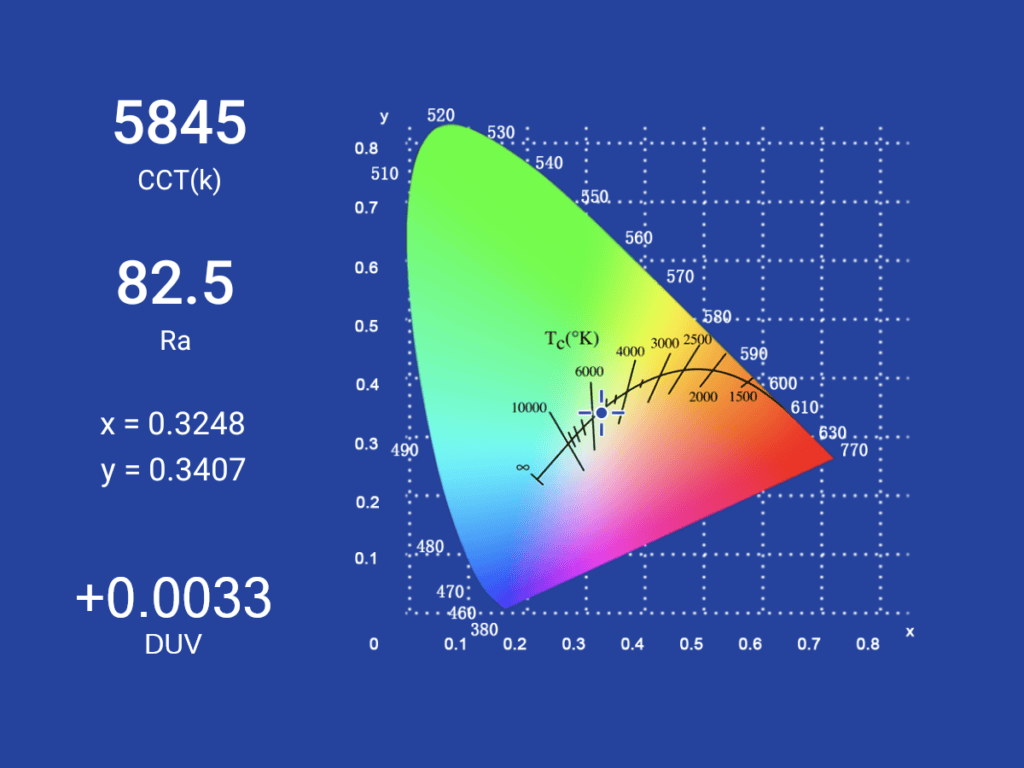
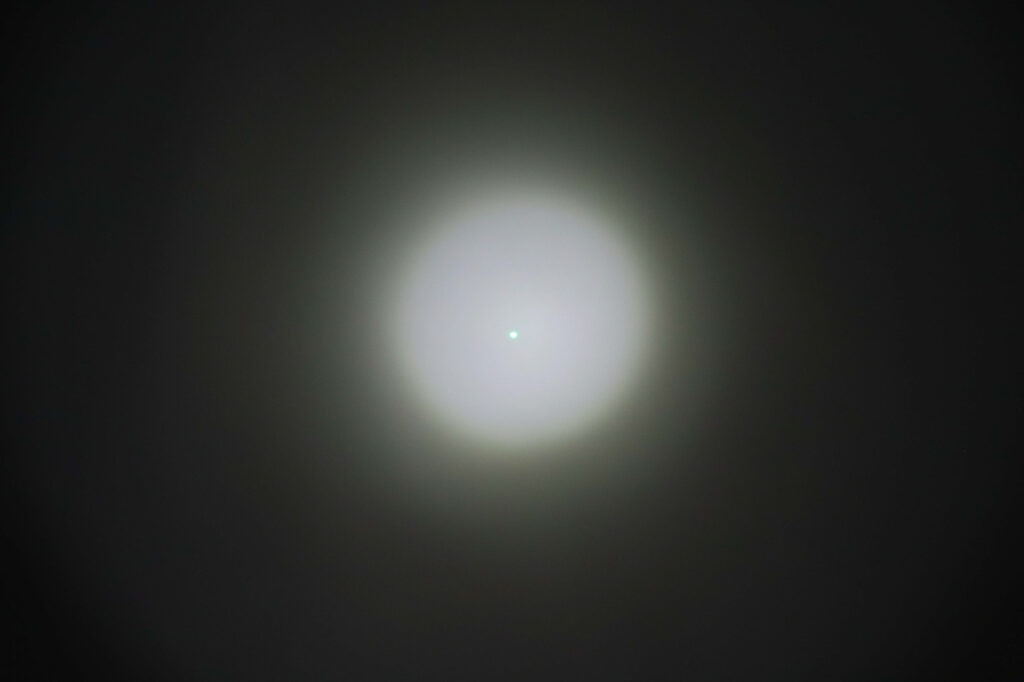
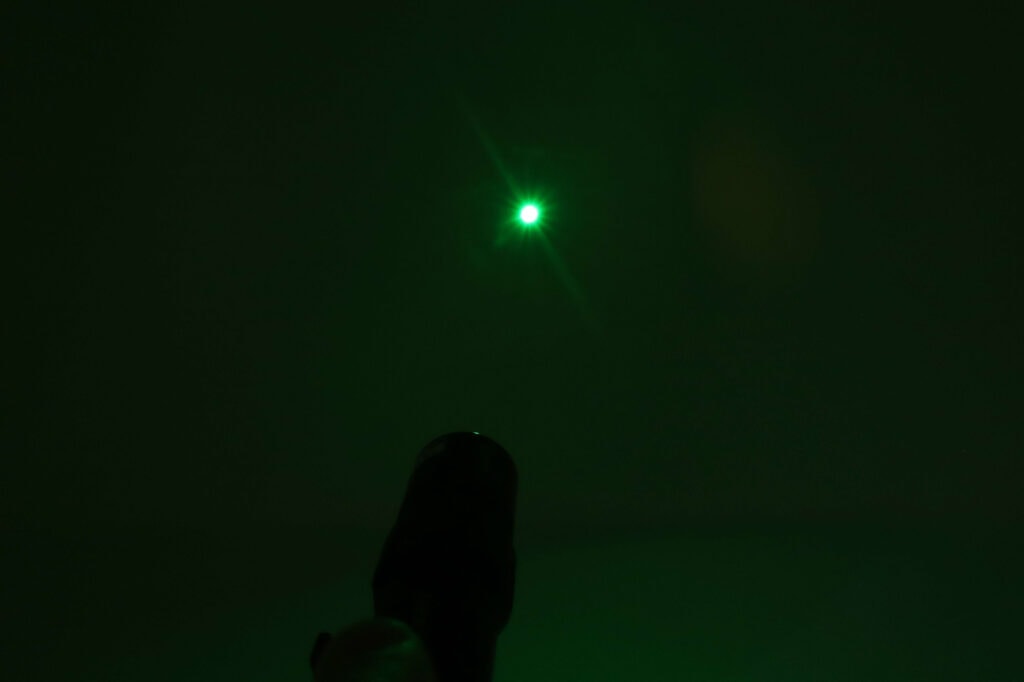
Dimensions and its competition
Dimensions:
| Olight Odin GL Mini | Millimeters | Inches |
|---|---|---|
| Length | 128 mm | 5.0 in |
| Head diameter | 29 mm | 1.1 in |
| Body diameter | 27 mm | 1.0 in |
Dimensions are rounded to the nearest millimeter and the nearest tenth of an Inch.
Weight:
| Olight Odin GL Mini | Weight in grams | Weight in oz |
|---|---|---|
| Without battery, mount: | 115 g | 4.1 oz |
| With battery, no mount: | 150 g | 5.3 oz |
| With battery and mount: | 190 g | 6.7 oz |
Weight is rounded to the nearest gram and tenth of an Oz.
Flashlight size comparison with its competition:
Group 1: Olight Baton 3 Pro Max, Olight Odin GL Mini, Olight Arkfeld UV
Group 2: Nitecore EDC33, Olight Odin GL Mini, Nitecore P20iX
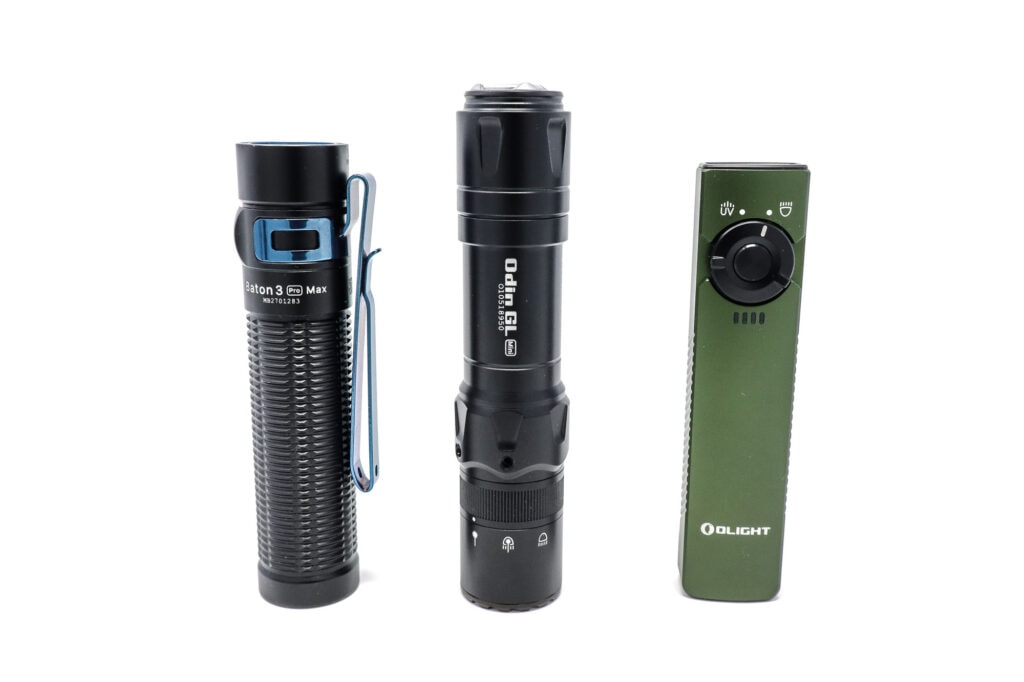
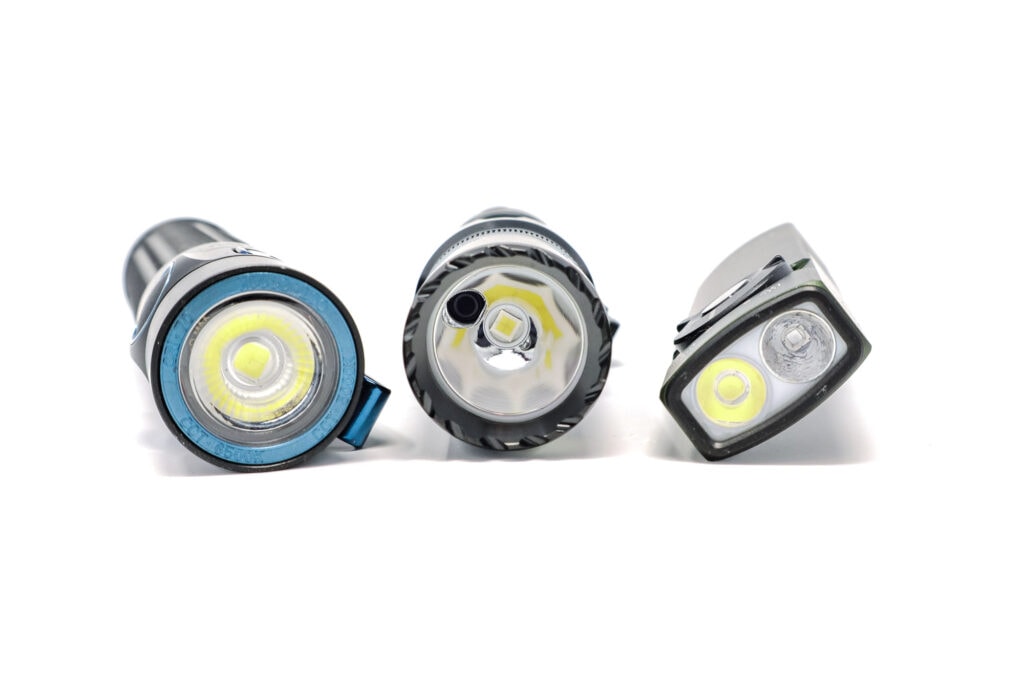
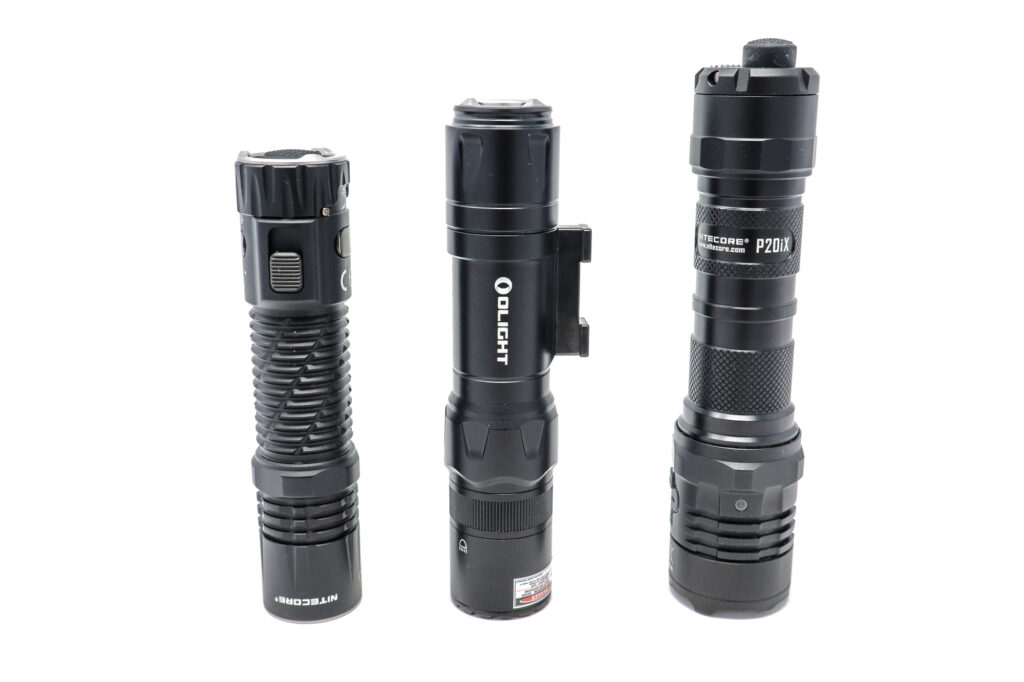
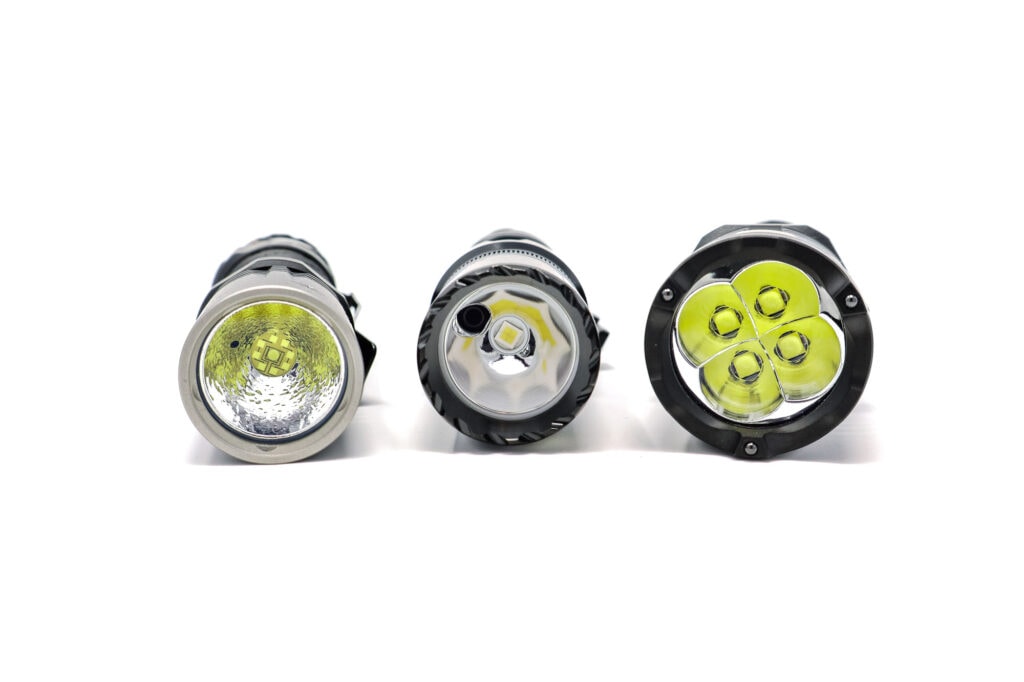
Olight Odin GL Mini UI: User Interface and Driver
The output of white LED, laser, or combo is controlled through a ring on the head of the flashlight that is clearly marked. I suppose you could consider this to be part of the UI, but it is so basic that I won’t bother describing it further below. Want just the laser? Twist the ring to the position that shows a thin ray. You get the idea.
The main two-stage switch is a bit different though. If you’ve ever used an Olight Warrior or something like that, you’ll be familiar with this. If you’re not in the loop on those, you might say it is similar to a camera shutter button where there is a halfway/shallow press (say, for focusing) and then a full depress (for taking the photo).
Available modes:
- Low, High
Available blinky modes:
- None
From OFF:
- Shallow press and hold: momentary Low
- Full press and hold: momentary High
- Shallow single click: turn on, Low
- Full single click: turn on, High
From ON:
- 1 click: turn off
Mode memory:
- None
Shortcuts:
- To Low: half press
- To High: full press
Low voltage warning/protection:
- This is another unique / standout feature for Olight’s more tactical products. When power drops under 20% the flashlight will vibrate once every 5 minutes. When less than 10%, once per minute. And under 5%, it’ll vibrate under 10 seconds.
- When I first experienced this, I thought it was odd. But how else do most other flashlights tell you that they’re running low on power? Flashing LEDs. If you’re in a tactical (or hunting) situation, do you want flashing LEDs? Nope. You want to know that you’re running out of juice without letting everyone/everything else know. Vibrating seems to be a good fit for that.
Strobe/blinkies
- None
Lock-out mode:
- None
PWM
- None detected
Additional/summary info on the UI:
- The UI of the Odin GL Mini is delightfully simple. There’s only 2 modes, and you can always get to either one of them.
Olight Odin GL Mini Charging and batteries
The Olight Odin GL Mini came with an Olight-branded 18500 battery. That’s right, an 18500… not an 18650. It has a stated capacity of 2040 mAh with a nominal voltage of 3.6, which translates to 7.3Wh. Like most Olight batteries, it is a proprietary format with a negative terminal ring at the traditionally positive end of the flashlight.
Like most Olight products, this flashlight uses the MCC charging format which is simple and effective. For peak charging rates, you should use a 10W (or higher) charger. The magnetic MCC attachment at the tail of the flashlight is simple and foolproof. Well, as long as you can tell the difference between red and green charging indicators (which I can’t reliably). Hey Olight – how about a red/blue or green/blue charging indicator? Or red flashing for charging?
| Charge type | Fits | No fit | Charge time |
|---|---|---|---|
| Flashlight with onboard MCC charging | Olight 18500 batteries | Almost anything else | 3h 30min |
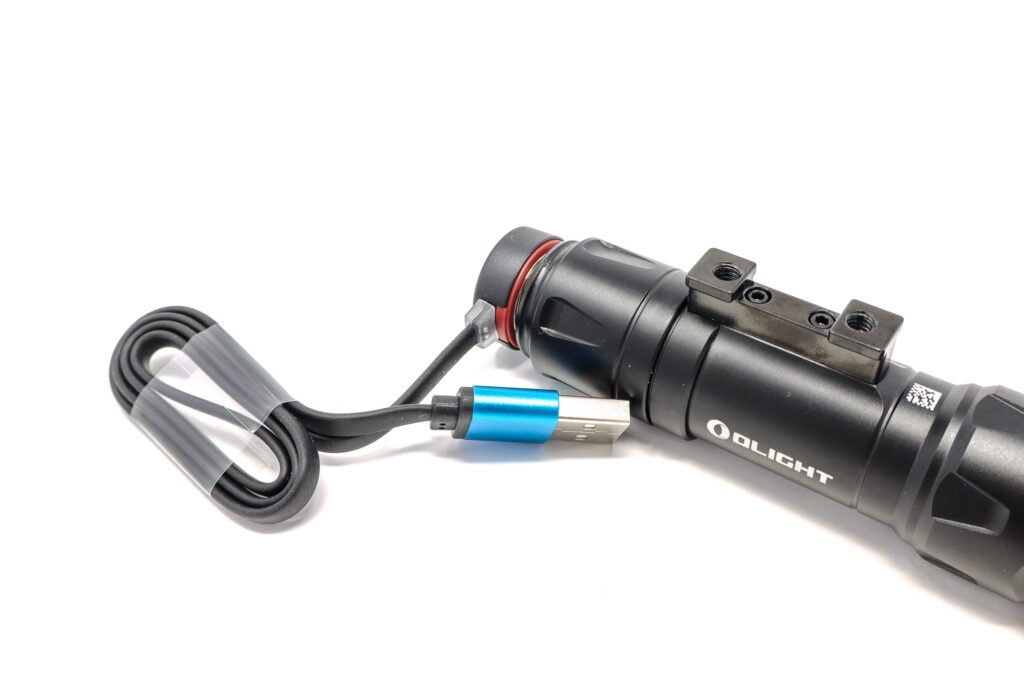
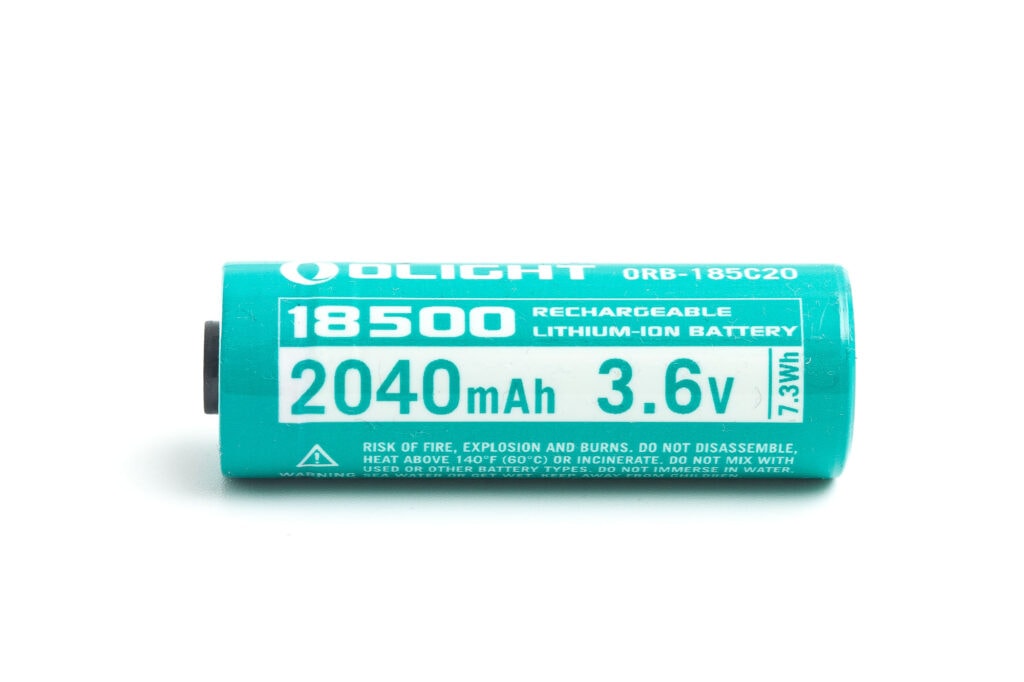
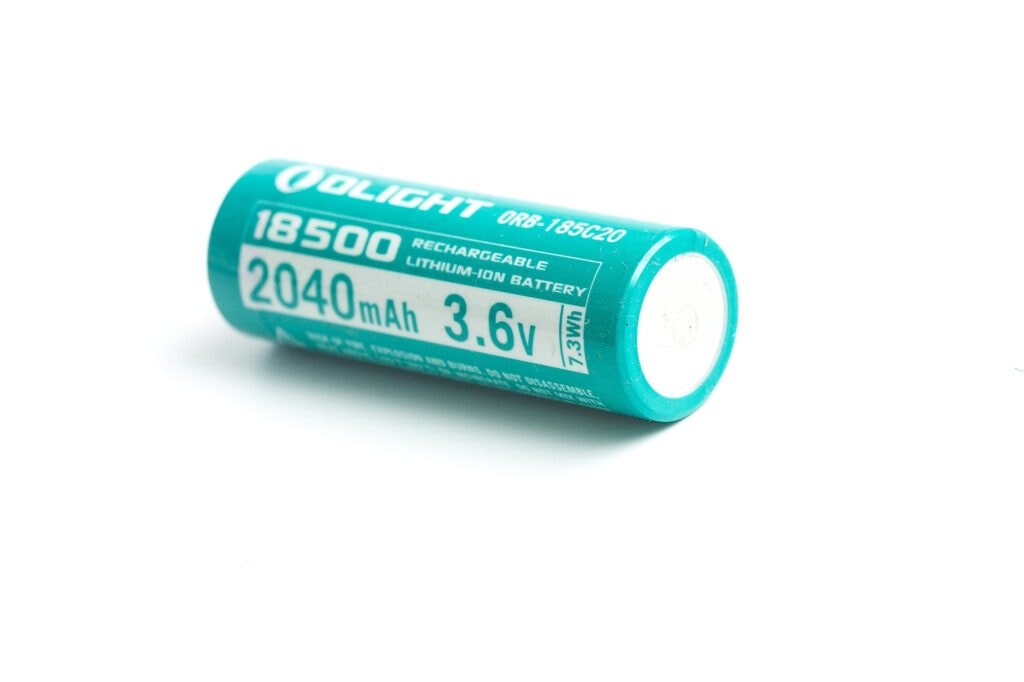
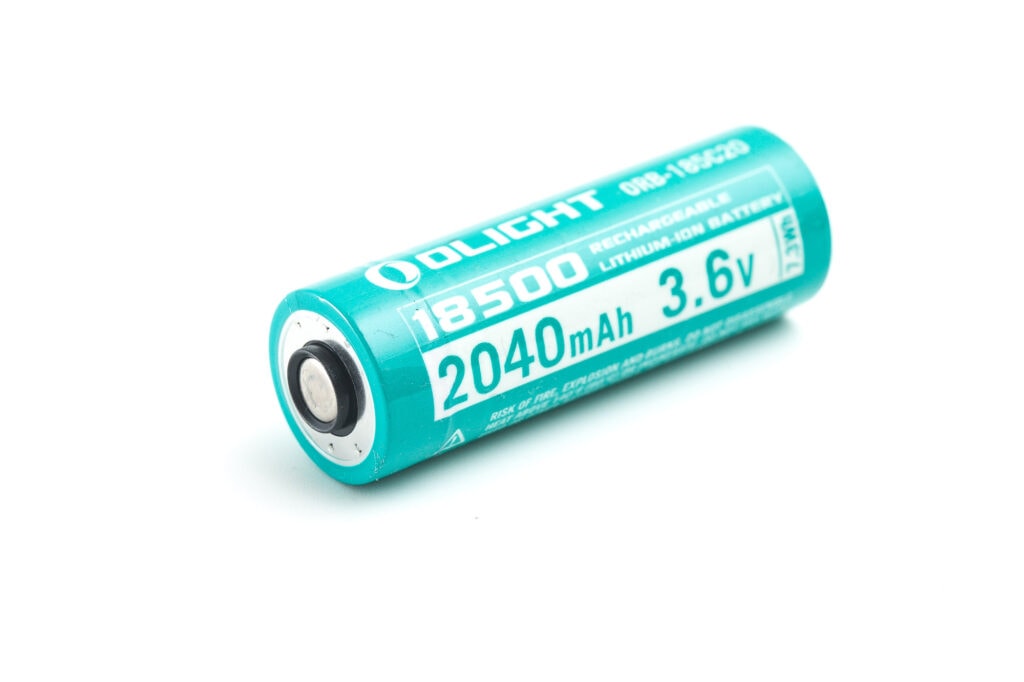
Performance test
Lumen measurements
How Lumens are Measured: Understanding ANSI FL1 Standards How Lumens are Measured: Understanding ANSI FL1 Standards: The ANSI FL1 standards specify that output in lumens should be measured 30 seconds after turning on, as this is the standardized time for measuring brightness according to the industry standard. This is why we focus on this part in our measurements. The ANSI FL1 standards require an ambient temperature of 22 ± 3°C. We record the ambient the ambient temperature to identify potential reasons for any observed discrepancies.Lux was measured by a UNI-T UT383 BT at 5 meters. Lumens were measured in a homemade lumen tube using a VEML7700 sensor, calibrated with a calibration light provided by 1Lumen. The included Olight 18500 battery was used in the tests.
| Mode | Specified | Turn on | 30 sec. | 10 min. |
|---|---|---|---|---|
| Low | 200 lm | 217 lm | 217 lm | 215 lm |
| High | 1000 lm | 1065 lm | 1047 lm | 517 lm |
Ambient temperature during testing:
- 20 °C
Parasitic drain:
- Couldn’t measure due to the flashlight design
The Odin GL Mini hit right at Olight’s claims. Is it the brightest light ever? Nope. But it is consistent and seems to be reliable, which I’ll take over crazy momentary brightness levels.
Olight Odin GL Mini Battery Life: Runtime graphs
How Runtimes are Measured: Understanding ANSI FL1 Standards About ANSI FL1 runtime standards: The runtime is measured until the light drops to 10% of its initial output (30 seconds after turning on). This does not mean that the flashlight is not usable anymore. The last column shows how long the light actually works till it shuts off. If there is a + symbol, it means that the test was stopped at that particular point, but the light was actually still running. This happens on certain occasions, with certain drivers, firmware, or batteries.| Mode | Specified | Runtime (ANSI FL1) | Time till shut off |
|---|---|---|---|
| Low | 3h 35min | 3h 43min | 3h 43min |
| High | 1h 24min | 1h 22min | 1h 22min |
Just like with the lumen test, there’s no surprises here. The Odin GL Mini did exactly what it was supposed to do. Nothing more, nothing less.
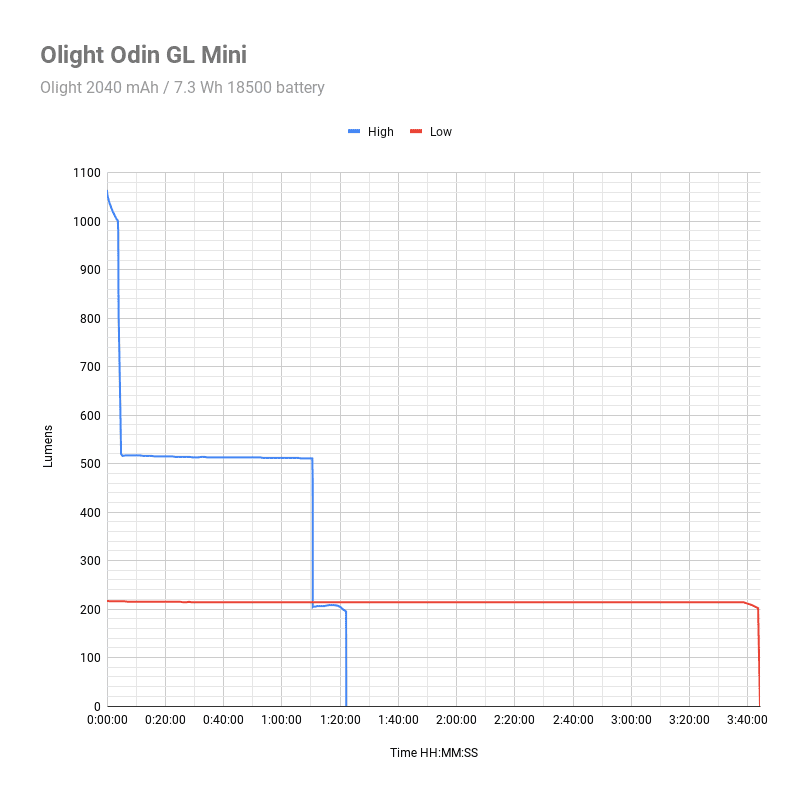
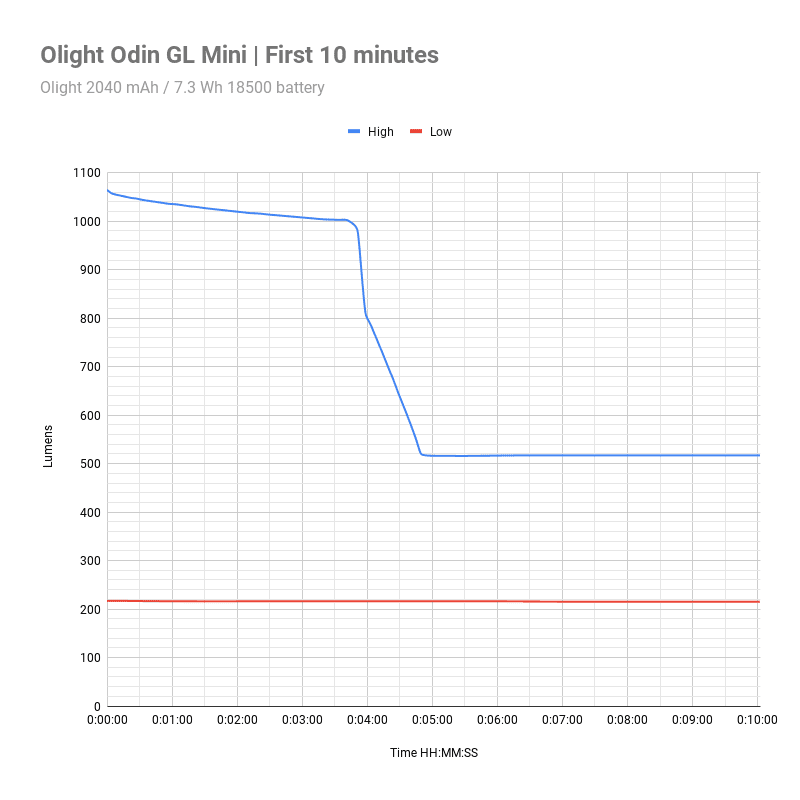
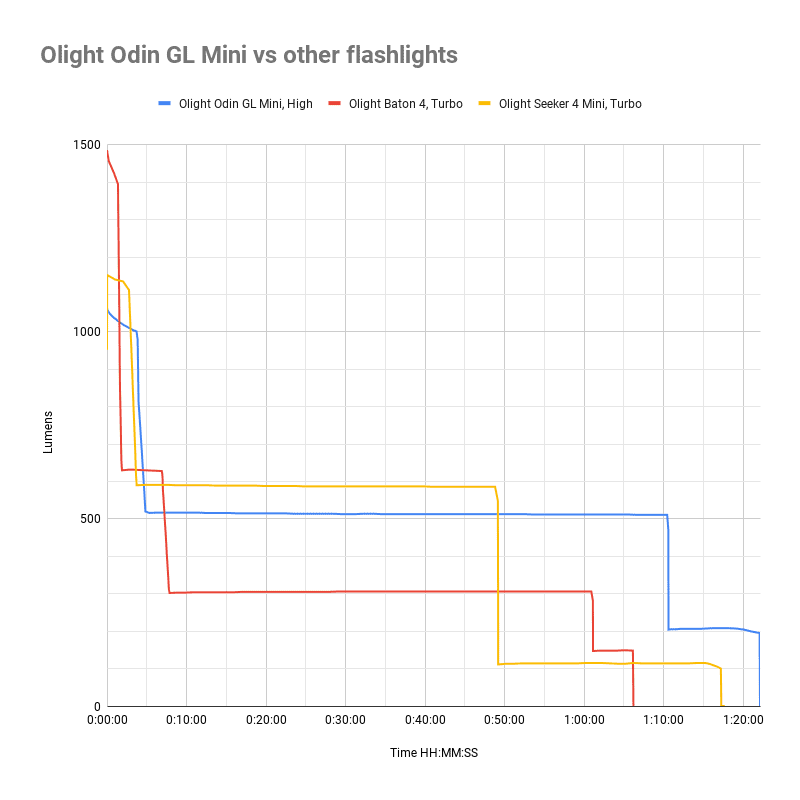
Compared to Olight Baton 4, Olight Seeker 4 Mini
Peak beam intensity and beam distance measurements
About Peak beam intensity: Understanding ANSI FL1 Standards About peak beam intensity The calculated value of distance in meters at which the flashlight produces a light intensity of 0.25 lux. (0.25 lux is about the brightness of a full moon shining on an object). This means that the intensity has decreased so much, it becomes difficult to see darker objects, or objects that don’t reflect light. The columns ‘Meters’ and ‘Yards’ use rounded numbers.Intensity was measured at 5 meters after being turned on for 30 seconds. A UNI-T UT383 BT lux meter was used.
| Mode | Specified | Candela measured | Meters | Yards |
|---|---|---|---|---|
| Low | 1,800 cd | 1,900 cd | 87 m | 95 yd |
| High | 8,100 cd | 8,550 cd | 185 m | 202 yd |
Ambient temperature:
- 20 °C
Consistency is a good thing, and so is coming in right at spec. It’s almost as if Olight performed actual testing on their flashlight and published true results. Oh wait, that’s assuredly what they did. I’m not sure what some of those other guys do, though.
Beamshots
Camera settings and distance: Beam shots of the building are taken at 30 m (33 yd) using a Canon EOS R100 with a lens set to 18mm. Manual settings: ISO 800, 1/4sec, F4.5, 5000K.
Beamshots of the following flashlights compared:
- Olight Odin GL Mini
- Powertac Warrior LT G5
- Olight Baton 3 Pro Max
- Olight Baton 4
Please note that the following beamshots are mainly intended to showcase the beam pattern and beam quality, rather than overall performance. These images are typically taken directly after activation, and in different seasons or weather conditions, and therefore do not fully represent its overall performance. For accurate performance metrics, such as output, beam distance, and runtimes, you need to look at the performance section of this review.
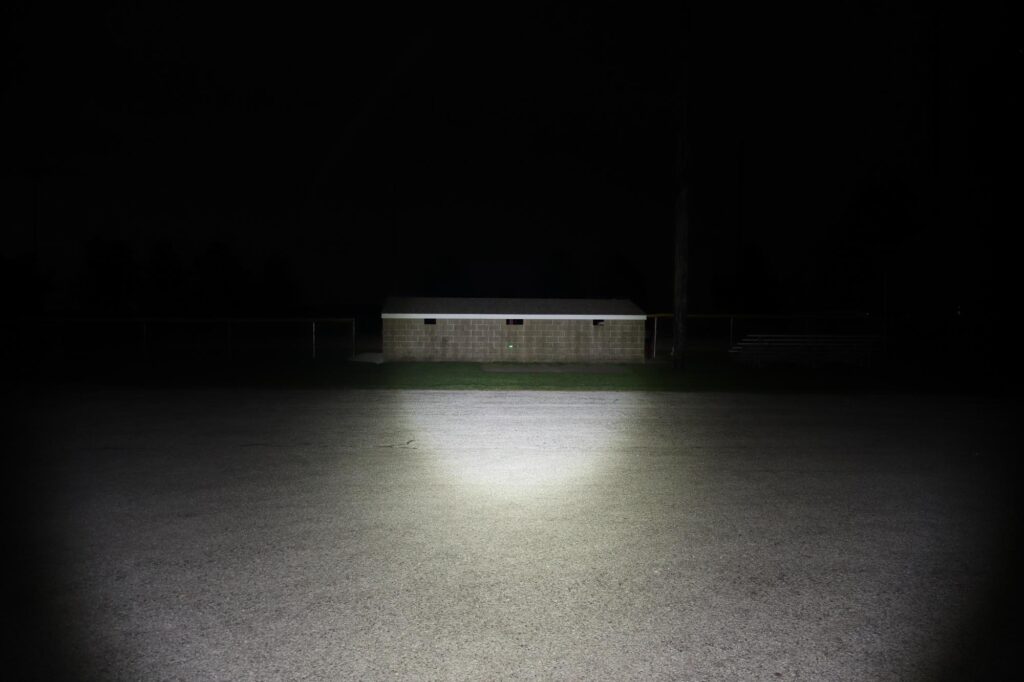
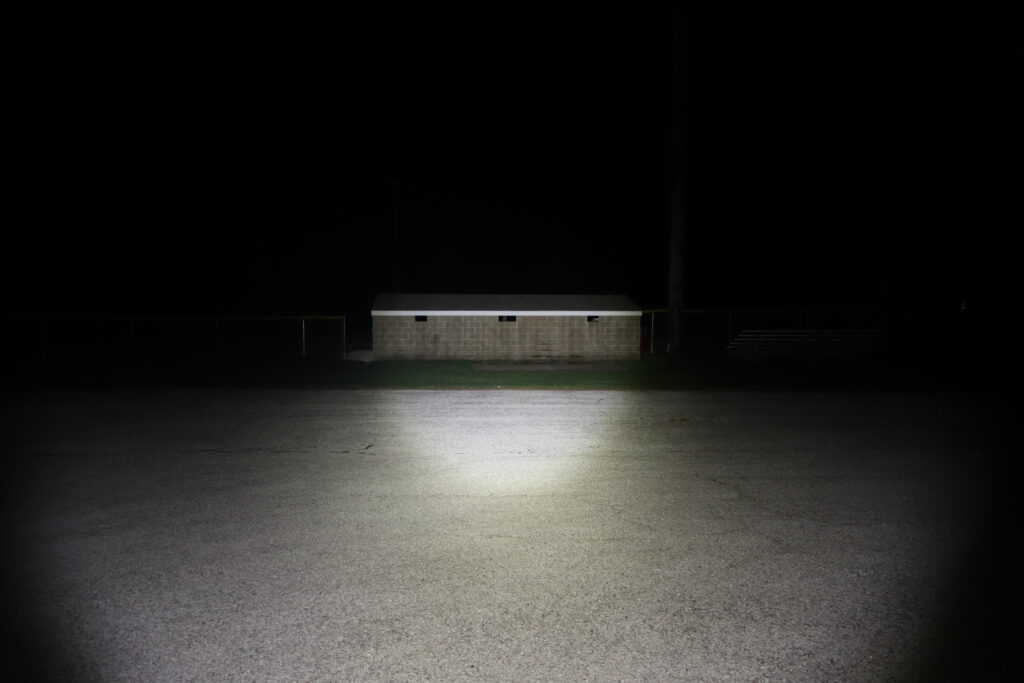
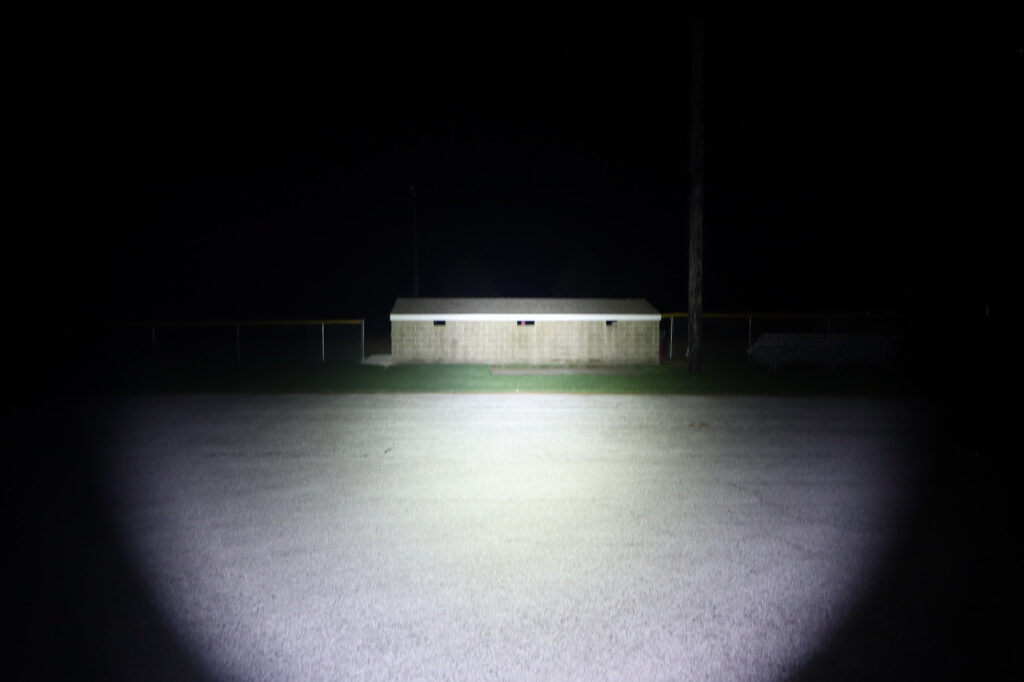
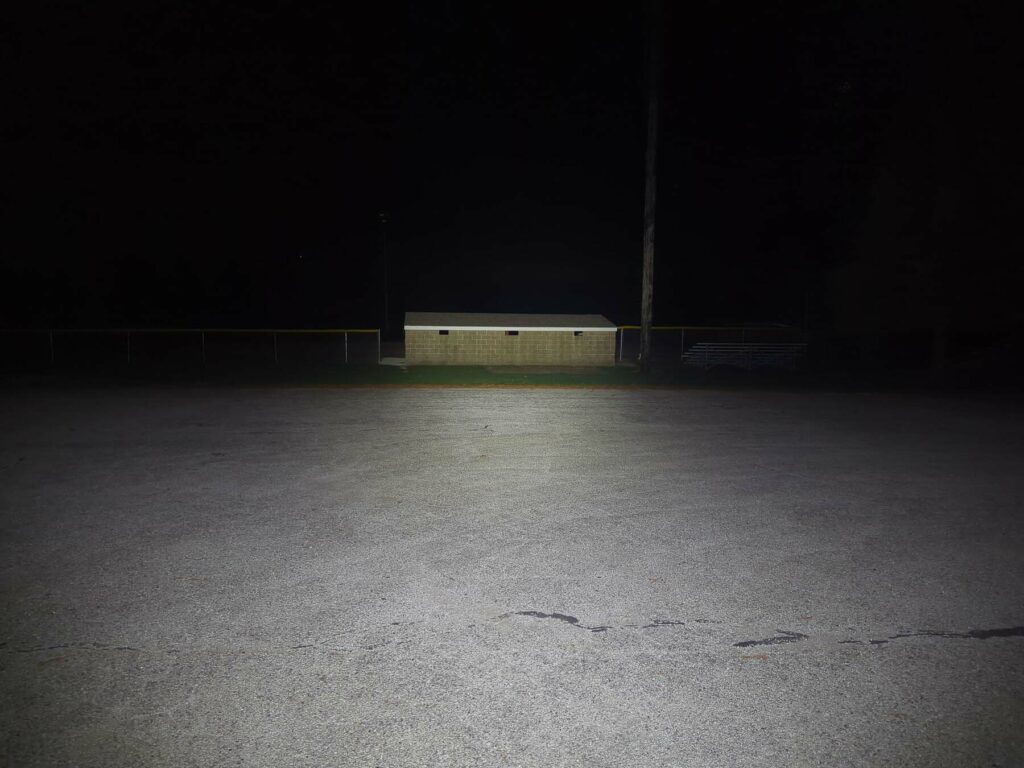
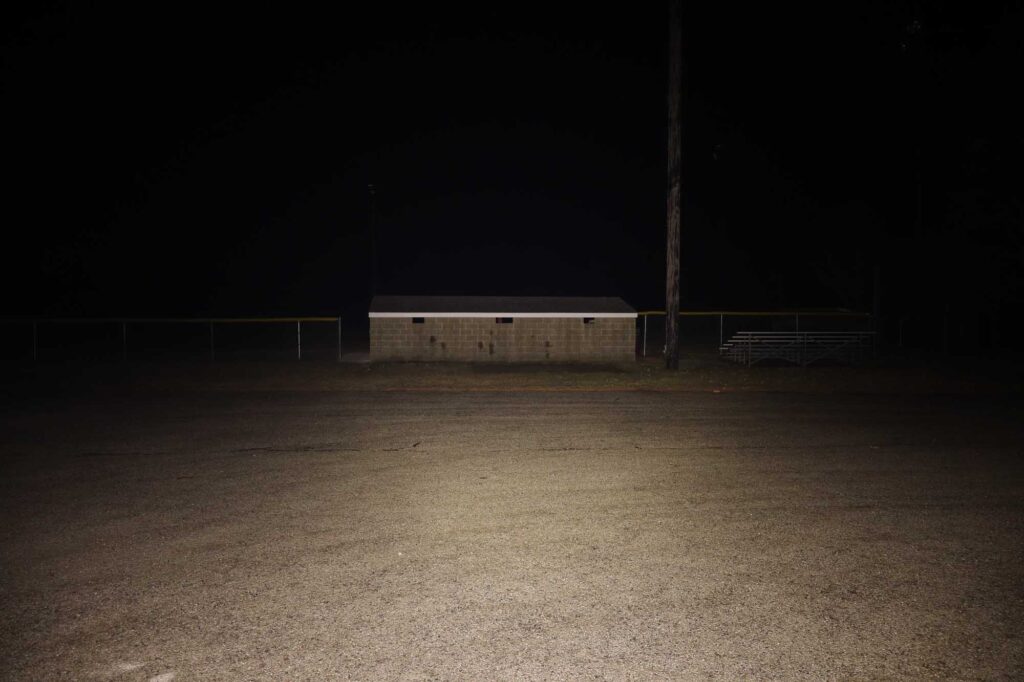


Disclaimer: This flashlight was sent to us for review at no cost by Olight. We have not been paid to review, nor have we been holding back on problems or defects.
Final Verdict
Pros
- Great build quality
- Full kit includes battery, rail mount, and remote pressure switch
- Easy, predictable UI & controls
- Stable output
Cons
- No direct MLOK compatibility
- Proprietary battery in a unique size
Explanation on star ratings:
1: Avoid: a match would be a better choice – 2: Poor: significant defect or issues; almost unusable – 3: Average: some defects or issues; but still usable 4: Good: recommended (minor issues) – 5: Great: highly recommended

4.5 stars: ★★★★⋆
While our star rating provides a reliable indicator, we encourage you to read the full review to make an informed decision based on your own needs and preferences.
Amongst Olight’s broad array of flashlight offerings, they have a fairly generous amount of weapon-mount lights. I have had Perun, Valkyrie, Baldr, and Odin, and Javelot lights on firearms, largely with good results. This Odin GL Mini is the first one I’ve tried in a while. I was looking for something appropriate for a long gun, preferably with a laser option for home defense.
My rifle has MLOK rails, and I don’t see an Odin offering (at the moment) with both MLOK mounting and a laser. So I went with the laser and installed it on a MLOK-to-Picatinny adapter. It seems to work ok. Perhaps not as clean as it could be, and not recommended according to the manual. There is an Odin Mini model that is made specifically for MLOK, but you give up the laser module. That decision is user preference, though I’d love to see a future revision that provides both features.
Mounting/output choices aside, I think the Olight Odin GL Mini is a great kit. You get everything you need to mount it on a firearm, including the weapon mount and a remote pressure switch. Adjusting the laser output to your aim point is straight-forward. Being rechargeable is a nice benefit, though if you want backup batteries, you’ll need to shell out for Olight’s unique and proprietary 18500 cells. I appreciate that that two-stage switch is easy to use and the two output levels are both directly accessible (and even easier from the remote switch!). If you’re in the market for a long-gun WML, I highly recommend this Odin GL Mini, or one of the other Odin models that may be more suitable to your rig.
Buy your Olight Odin GL Mini with a discount
Use our exclusive 1lumen discount code to get an extra 10% off anything you order at Olightstore.com (USA). Coupon code: 1lumen
1lumen selects and reviews products personally. We may earn affiliate commissions through our links, which help support our testing.